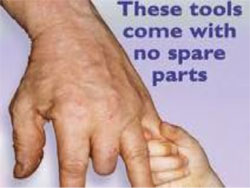Power Tool Safety
Accidents involving portable power tools happen all the time. You’ve all heard of cases where a chip flew off a drill and hit someone’s eye, or of someone getting a shock because a tool had a faulty ground. And then there’s the person who lost a finger because the guard on the circular saw did not return. In one recent year, there were more than 800 OSHA citations for violations of power tools standards (both general industry and construction), with penalties totaling well over half a million dollars. There are more than 100,000 hospital emergency room visits each year in the United States due to power tools accidents.

In some ways, portable power tool accidents are more serious than those associated with stationary machines because:
-
Portable power tools are difficult to guard completely.
-
They’re mobile, so they run a greater risk of coming in contact with the user’s body.
-
They are easily dropped and damaged, so there’s a risk of them being used when faulty.
- The power source (electrical, hydraulic, etc.) comes in close contact with the operator.
Know the Tool:
Reading the manufacturer’s instructions is a good start. And if you’re completely unfamiliar with the tool, talk to someone else who has used it.
Understanding how to use it does not mean that you’re ready to turn it on. Again, you have to know the tool.
Look at it closely. Make sure that:
-
It’s not missing any parts, especially safety guards;
-
There are no loose or dull blades;
-
The plug and cord insulation are intact;
-
There are no defects or cracks in the tool housing; and
- Guards and safety shut-off switches are in good working order.
This kind of inspection should be done every time you start an operation using a power tool.
Don’t be a fool…inspect your tools!!
Download flyer: STOTW_32_PowerToolSafety.pdf (91.73 kb)

